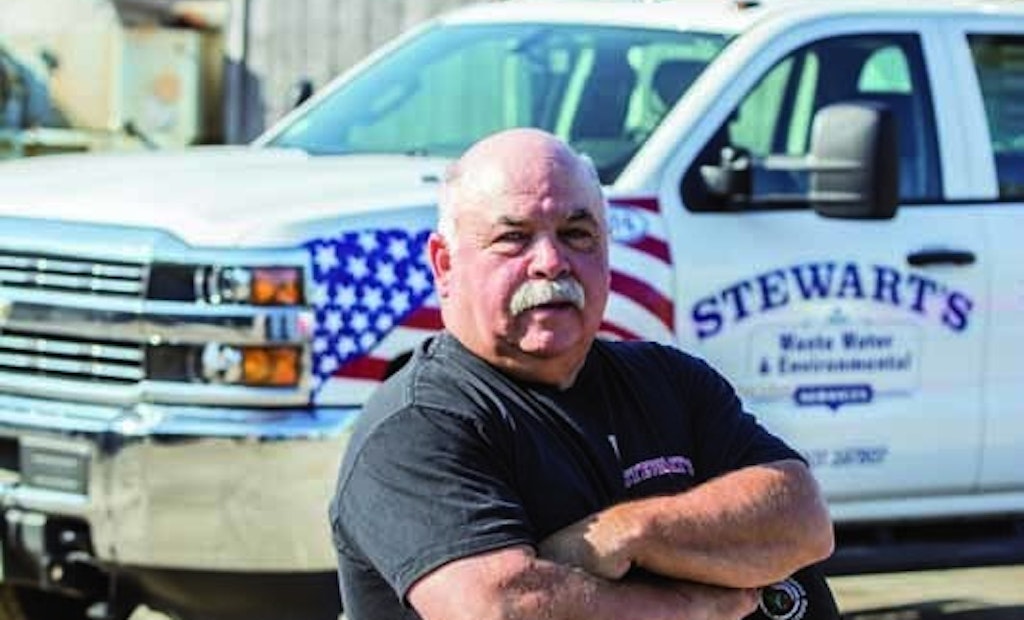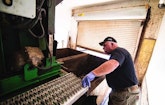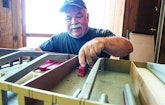
Interested in Pumps?
Get Pumps articles, news and videos right in your inbox! Sign up now.
Pumps + Get AlertsThanks to timely acquisitions of other pumping companies, diving into the fats, oils and grease business, and pioneering private wastewater processing, Stewart’s Septic Service has grown from a mom-and-pop outfit into a big pumping player in New England.
A lot of wastewater has passed through the Bradford, Massachusetts-based company over the years, and owner John Divincenzo was already successfully treating collected waste when Pumper first profiled Stewart’s in 2003.
Today, the company continues to reach for new frontiers, now converting grease into dollars, selling it as the raw material for biofuel production. And Divincenzo and his crew keep learning by attending the Water & Wastewater Equipment, Treatment & Transport (WWETT) Show and taking part in COLE Publishing’s Pumper Profit Series seminars.
Divincenzo and his father-in-law, Sam Busa, bought Stewart’s Septic in 1987 to bring in supplementary revenue to Busa’s recession-stung construction business. Soon they saw the potential of the wastewater industry, and Divincenzo quit his day job as a pipefitter and became a full-time pumper. The results soon eclipsed the duo’s modest expectations.
GROWTH TRAJECTORY
Divincenzo bought out Busa in 2001 and now owns the company with his wife, Jane, the majority owner who handles the company’s finances. The couple’s two daughters, Tania and Angela, also work at Stewart’s.
Today, Stewart’s employs 25 people and runs 13 vacuum trucks across New England. Residential septic tank pumping and septic system repairs, maintenance and inspections generate about 60 percent of the company’s sales. The balance comes from commercial accounts, which includes both grease trap and septic pumping, he says.
Divincenzo started out with four vacuum trucks and a service van, but he quickly expanded. In 1990, he purchased Kelleher Sewer Service in Salem, New Hampshire, followed by the acquisition of Andover Septic Service in Andover, Massachusetts. “One guy was retiring and the other guy was moving to Florida,” he says. “It made sense geographically because both companies were within about an 8-mile radius from our company.”
Along with the acquisitions, Divincenzo built a reputation for going the extra mile for customers. The result? A lot of word-of-mouth referrals. “When people call, we accommodate them, even if it’s 2 a.m. We grew the business by doing good work — we’re not afraid to get our hands dirty, that’s for sure. Even today, I’m not afraid to jump on a truck and help out.”
TAKING CONTROL OF TREATMENT
While the acquisitions fueled growth, building a treatment plant for septic waste in 1994 proved to be a game-changer, reducing fuel and other transportation-related costs, as well as decreasing disposal fees. Lower operating costs, in turn, enabled Divincenzo to charge lower rates than competitors, which helped him gain market share. And rising revenues provided capital to invest in newer, more productive equipment, he says.
Stewart’s is permitted to process 100,000 gallons of septage per day. Here’s how the system works: The septage first goes through a Muffin Monster, a sewage and sludge grinder manufactured by JWC Environmental. Then the waste travels by gravity through five 40,000-gallon concrete settling tanks; the tanks are about 14 feet wide, 8 feet deep and 30 feet long. “We bought land across the street from our facility that used to belong to a tannery,” Divincenzo explains. “The tannery had an industrial waste treatment system that we converted into a septic waste treatment system.” Solids settle to the bottom of the tanks, which get pumped out periodically; Stewart’s hauls the sludge to a sewage treatment center. The effluent left after the solids settle out drains into a municipal sewer system, he says.
“I was pretty confident it was going to work out,” say Divincenzo, who estimated he invested roughly $1.4 million in both the septage- and grease-processing systems. “A lot of bigger companies don’t want anything to do with treatment facilities. But I try to build my company around treatment plants.
“It’s just more sensible to me,” he continues. “It makes us more efficient and it’s a big money-saver. We reached a point where if we had trucks coming in after 5 p.m., there wasn’t anywhere open to dump the waste. So the trucks would sit full overnight and we’d have to start the day by going on a dumping run, which wasted time.”
GREASE IS THE WORD
Increased efficiencies and financial benefits also prompted the company to develop the grease-processing system in 2002. On one hand, it was becoming more and more difficult to find treatment facilities that would accept grease trap waste. And on the other side of the equation, why pay to get rid of the waste when someone will pay you for producing a refined version of it? It was, as he notes, a no-brainer.
Here’s how the grease-processing system works: In the first step, the waste passes through a shaker, made by Derrick Corporation. Typically, shakers are used at oil and gas drilling sites to separate things like drill cuttings and fluids, but Divincenzo adapted a unit to separate grease from solids. “It basically does the same thing to grease trap waste that the Muffin Monster does for septic waste,” he says.
Next, the grease goes into a heated 6,000-gallon tank that’s heated to about 150 degrees by a Smith Cast Iron Boiler. This separates the oils from water and food particles.
Then it passes through a vibratory shaker, made by Kason Corporation, which removes even finer particles. From there, the waste goes into a drum shaker, which removes even finer particles.
In the last phase, the waste passes through stainless steel filters and into a centrifuge machine made by Alfa Laval. Any remaining solids drop into a bin, wastewater goes into the sewer line, and the processed grease — known as yellow or brown grease — is stored in a heated 22,000-gallon steel frac tank made by Dragon Products Ltd. It’s later sold for roughly 60 to 80 cents a gallon to a South Carolina company that uses it to make biofuel, Divincenzo says.
“We don’t make a fortune on it, but I’d rather get paid for it than pay to get rid of it,” he explains. “It also saves us a lot of money.” The system can process about 6,000 gallons of grease trap waste and produce from 1,600 to 1,800 gallons of brown/yellow grease daily.
IN THE GARAGE
The company’s fleet of equipment has grown substantially since its early days. To clean septic tanks, the company runs 11 vacuum trucks built on Mack, Peterbilt, Freightliner and International chassis. The trucks carry tanks (mostly aluminum), ranging from 2,000 to 7,500 gallons, and pumps from Jurop/Chandler or Battioni (National Vacuum Equipment). Most of the trucks were self-fabricated by Stewart’s; one was built by House of Imports. The self-fabricated rigs include tanks made by Progress Tank and Keith Huber Corp. Two of the vacuum trucks are equipped with a Mustang self-fabricated, portable waterjetting unit, Divincenzo says.
In addition, the company owns two Caterpillar excavators, a John Deere skid-steer and mini-backhoe, a Case backhoe (CNH Industrial America LLC), and three dump trucks (chassis made by International and General Motors) with 8- to 16-cubic-yard dump boxes made by Heil (owned by Dover Corp.), Beau-Roc (Les Ateliers Beau-Roc Inc.) and Air-Flo Manufacturing Co. The company also relies on a Crust Busters tank agitator, three Conde ProVac units (Westmoor Ltd.), and an International box truck that carries a small hydroexcavating unit with a 1,700 cfm blower from Roots Systems Ltd. and jetter from Mustang (2,000 psi at 3.5 gpm).
For general service vehicles, the company owns two Ford pickup trucks with utility bodies made by The Reading Group LLC; a Chevrolet pickup; and a 2005 Freightliner truck outfitted with built-in toolboxes and a 5,000-pound-capacity crane made by Iowa Mold Tooling Co. Inc.
To haul large amounts of waste more cost-effectively (primarily taking sludge from the company’s treatment plant to municipal treatment facilities), the company relies on one 8,000-gallon and one 9,000-gallon tanker trailer (one from Arthur Custom Tank), and two Peterbilt 379 tractors pull the tankers. The company also owns three trailer-mounted jetters, two built by John Bean (owned by Durand-Wayland Inc.) and one by Hot Jet USA.
LOOKING AHEAD
Divincenzo anticipates more growth for Stewart’s in the coming years. He expects that further acquisitions will be a key part of that growth. Right now, the company finds itself in a position that vexes many businesses: Despite consistent revenue growth, profit margins remain level.
“If you think of it as a seesaw, right now we’re staying right in the middle, with no movement up or down,” he says. “The only way for us to grow now is to cut costs and grow the business at the same time, because the profits seem to stay the same even though we keep adding more guys and trucks.”
As such, the company has plans to buy two companies in Maine, as well as a small treatment plant. “We already service that area, but we want to do it better,” he says.
“(Buying the companies) will save us a tremendous amount of money.’’
“Currently, we go all the way up there with empty trucks and come back full … so we’re not producing (revenue) on the way up,” he explains. “If things work out the way I expect, we’ll be able to bring a full truck up there, dump waste and then make service calls while working our way back down here, and the trucks will always arrive with full loads.”
In the meanwhile, Divincenzo, 60, says the company overall is busier than it’s ever been and he has no plans to retire anytime soon.
“Some day,” he says of retirement. “But right now I’m still healthy enough to keep moving. We’ve got a 42-foot RV ready for retirement, but we haven’t talked too seriously about it. Maybe the kids can take over the business some day and send us a check every week. But in the meanwhile, we’ll keep plugging away. I love what I do.”
Pumper profits from WWETT Show, education seminars
Every year, John Divincenzo relies on a secret weapon that stokes his enthusiasm for the industry, rewards employees, improves operations and introduces the latest and greatest in equipment: the Water & Wastewater Equipment, Treatment & Transport (WWETT) Show.
“The show is my salvation — I love going,” says the owner of Stewart’s Septic Service in Bradford, Massachusetts. “I don’t get many days off, so when I get down there it’s so great to relax and talk to people. … We’ve developed very strong relationships with other pumpers and meet them for dinner.
“It’s also great to see all the new products,” he continues. “Every year we bring something new home with us, whether it’s just a small jetting nozzle or a whole jetting unit.”
Divincenzo typically rewards several deserving employees by taking them with him to the WWETT Show. He says it’s invaluable for those employees to meet fellow pumpers, talk to vendors and see new products that can help improve efficiency and productivity. “It’s a great way to thank them for what they do for us,” he says. “We pay them for their time there and cover all their expenses. Everyone I’ve brought to the show talks about it all the time after we go back home. It really recharges their batteries.”
The veteran operator also benefits from the Pumper & Cleaner Profit Series. Divincenzo’s daughter Angela, the company’s dispatcher, and Ashley Cronin, assistant to Jane Divincenzo, attended the three-day Profit Series in Florida in March 2015 and returned home with several ideas to improve operations.
One topic covered was the value of company uniforms. Stewart’s drivers have uniforms, but they had stopped wearing them consistently. So the company started enforcing its uniform policy more stringently, Angela Divincenzo says. Uniforms make drivers look more professional; that, in turn, can lead to repeat business as well as allow pumpers to better justify their rates because professionalism creates a higher perceived value. “It helps if someone pulls up at a home and looks clean and is driving a clean truck,” she notes. “And the uniforms also help with repeat business because new customers see the company’s name on more than just the truck.”
The women picked up valuable pointers about what to look for in a software program that could help the company more efficiently computerize its operations. “The seminars were very useful,” she says. “They helped me realize there are many simple things we can change to make our company operate better.”










